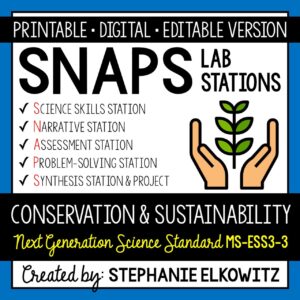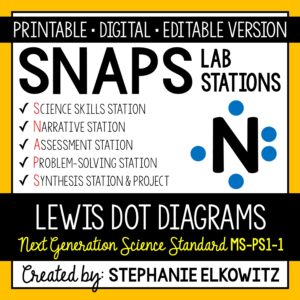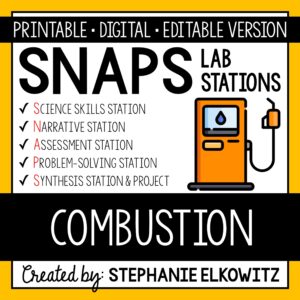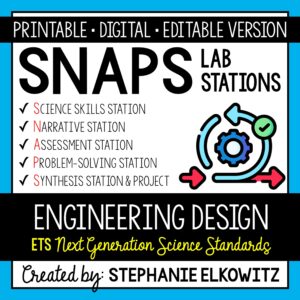SNAPs Lab Stations Startup Guide
$0.00
A FREE guide that details best practices for SNAPs labs and provides editable and digital documents important to all SNAPs lab activities.
Description
• The guide provides an overview of SNAPs Labs
• The guide details best practices important to executing SNAPs Labs
• The download includes editable and digital documents important to all SNAPs Labs
• The guide includes suggestions to help troubleshoot common difficulties and issues
The goals of the setup guide include:
• Summarize the benefits of SNAPs lab station activities
• Explain the objective of each SNAPs lab station
• Provide documents that summarize objectives and materials for all labs
• Explain how NGSS-aligned labs meet performance expectations
• Provide suggestions and best practices for lab station implementation
• Offer alternative applications for lab station activities
• Suggest solutions to potential problems that may occur with lab activities
This download includes:
• A 46-page setup guide
• Signage for lab stations
• EDITABLE Lab Portfolio Table of Contents
• EDITABLE Synthesis Project Options
• EDITABLE Synthesis Project Grading Rubrics
• EDITABLE Lab Journal Template
• EDITABLE CER Report Template
• Digital Synthesis Project Rubrics (designed for Google Classrooms)
• Digital Lab Journal (two versions – created as a fillable slide)
• Lab Support Videos: https://bit.ly/3UpnmP8
About SNAPs Lab Station Activities
A SNAPs laboratory includes station activities designed to develop students’ science skills with hands-on activities and thought-proving exercises. The labs require students to use science, math, literacy, problem-solving and engineering skills so to expand their understanding scientific ideas and apply scientific concepts to the real world.
SNAPs lab activities have five components:
• Science Skills Station to develop science skill proficiency
• Narrative Station to build science literacy
• Assessment Station to evaluate learning and understanding
• Problem-Solving Station to foster engineering design
• Synthesis Station and Project to inspire higher-order learning
Science Skills Station
Students explore a concept using science and math skills. The skills may be procedural that a student must physically do. The skills may be mathematical or require scientific thinking and reasoning.
Narrative Station
Students employ literacy skills important to understanding scientific text as well as illustrations, tables and graphs. In many labs, students will explore multimedia sources, such as videos, audio files or animations.
Assessment Station
Students answer multiple choice questions, short answer questions and/or open-ended, thought-provoking questions. The questions progressively get “harder” and require students to employ lower, mid and higher order thinking.
Problem-Solving Station
Students utilize the engineering design process and problem-solving skills so to identify problems, test solutions and/or make improvements to solutions.
Synthesis Station
Students compose a CER report as a lab conclusion so to relate the observations, data and other information gathered in the lab to the objective(s) of the lab.
Synthesis Project
Students complete an activity or project that helps summarize information studied and learned in the lab. This facilitates “bringing it all together” while getting students to think harder and deeper about a concept.
TERMS OF USE
• All rights reserved by Stephanie Elkowitz.
• This product is to be used by the original purchaser only.
• Intended for classroom and personal use only.
• Copying for more than one teacher, classroom, department, school, or school system is prohibited.
• This product may not be distributed or displayed digitally for public view.
• Failure to comply is a copyright infringement and a violation of the Digital Millennium Copyright Act (DMCA).









